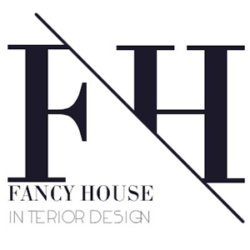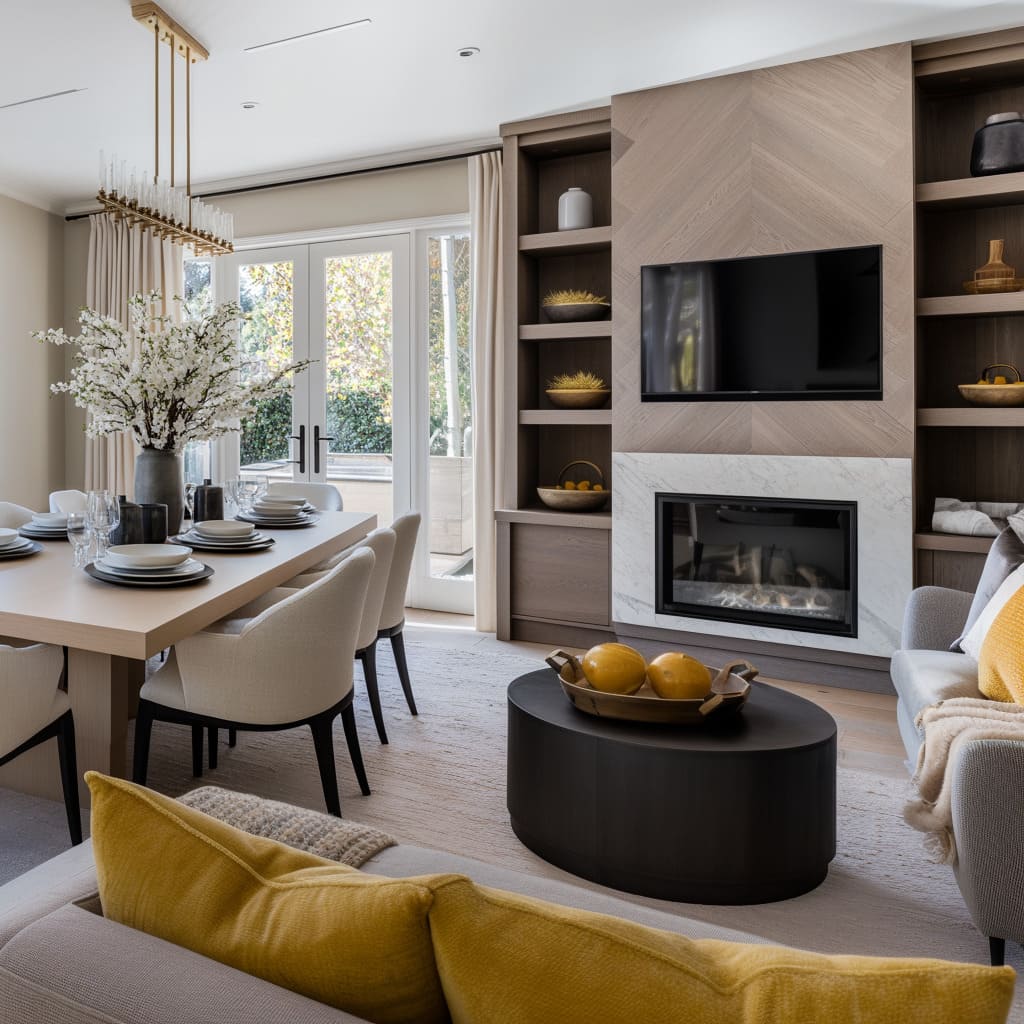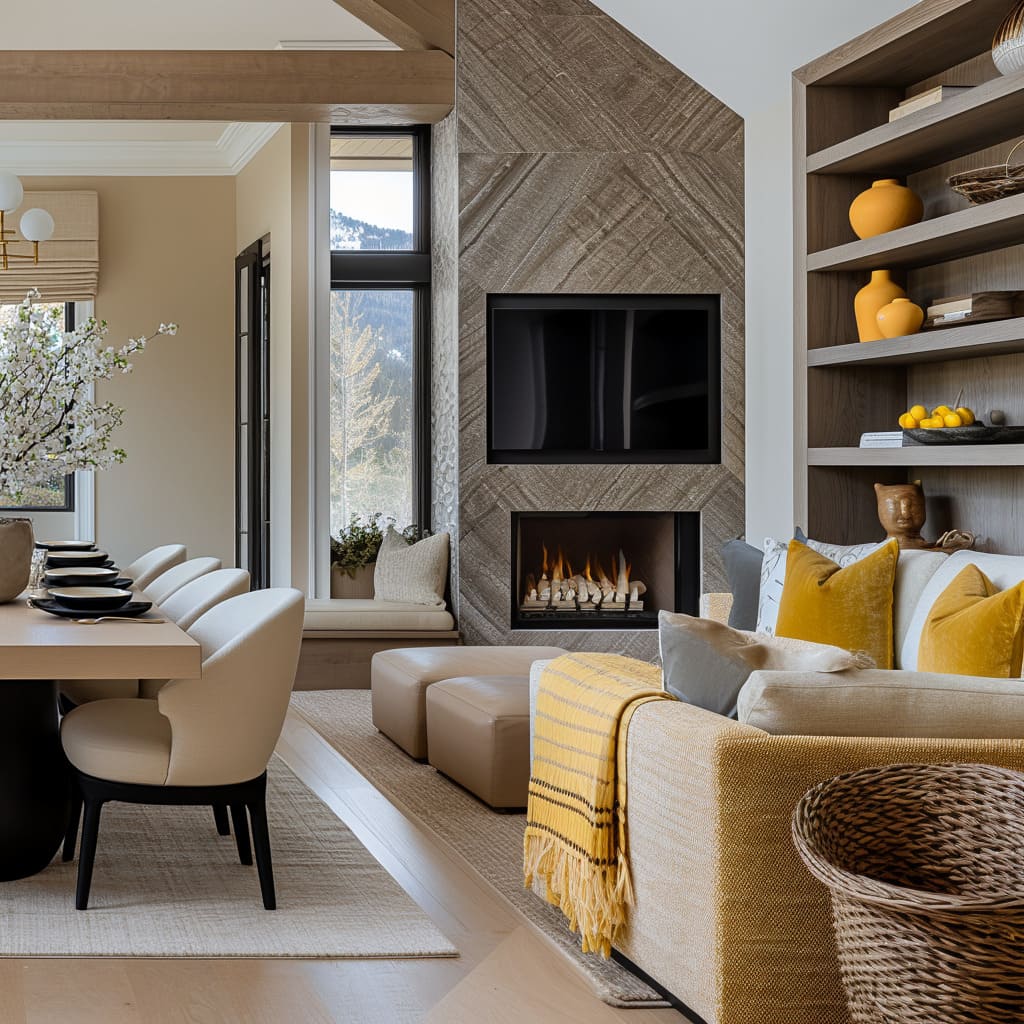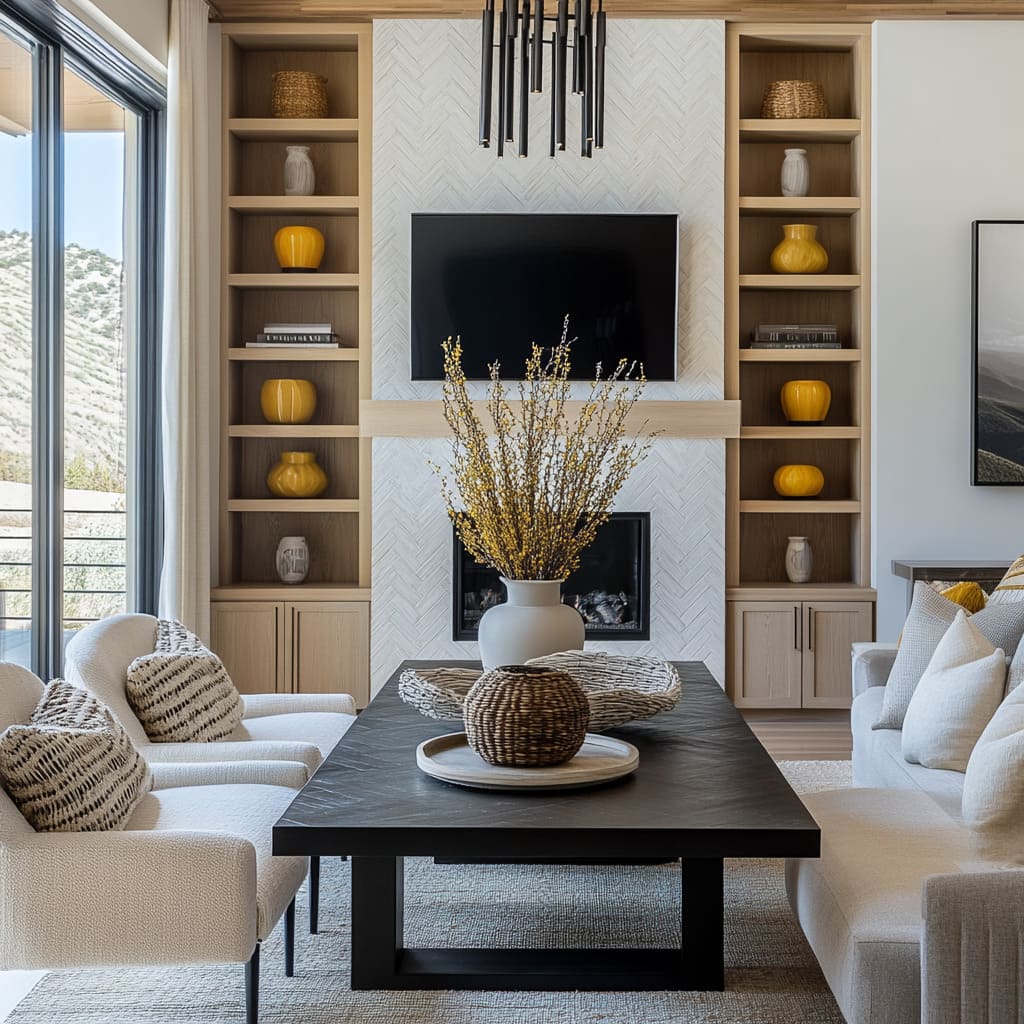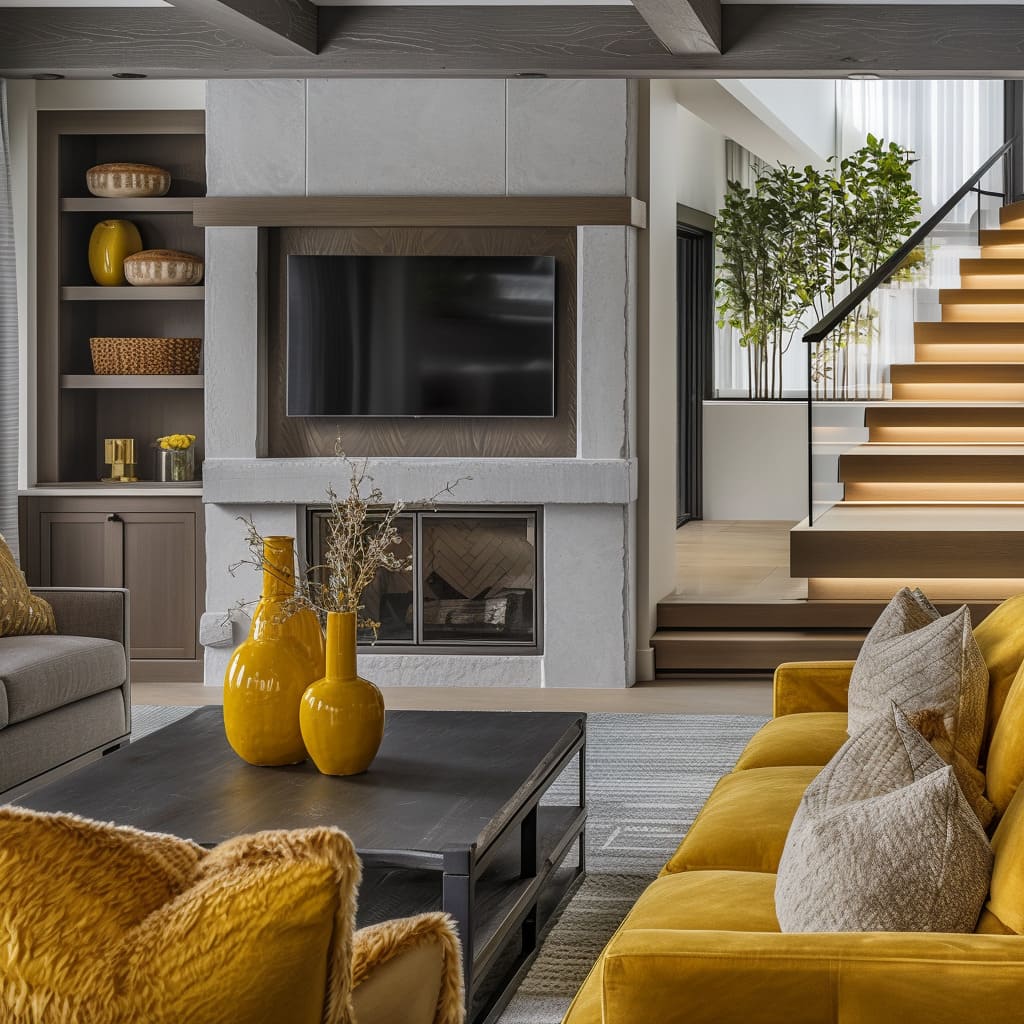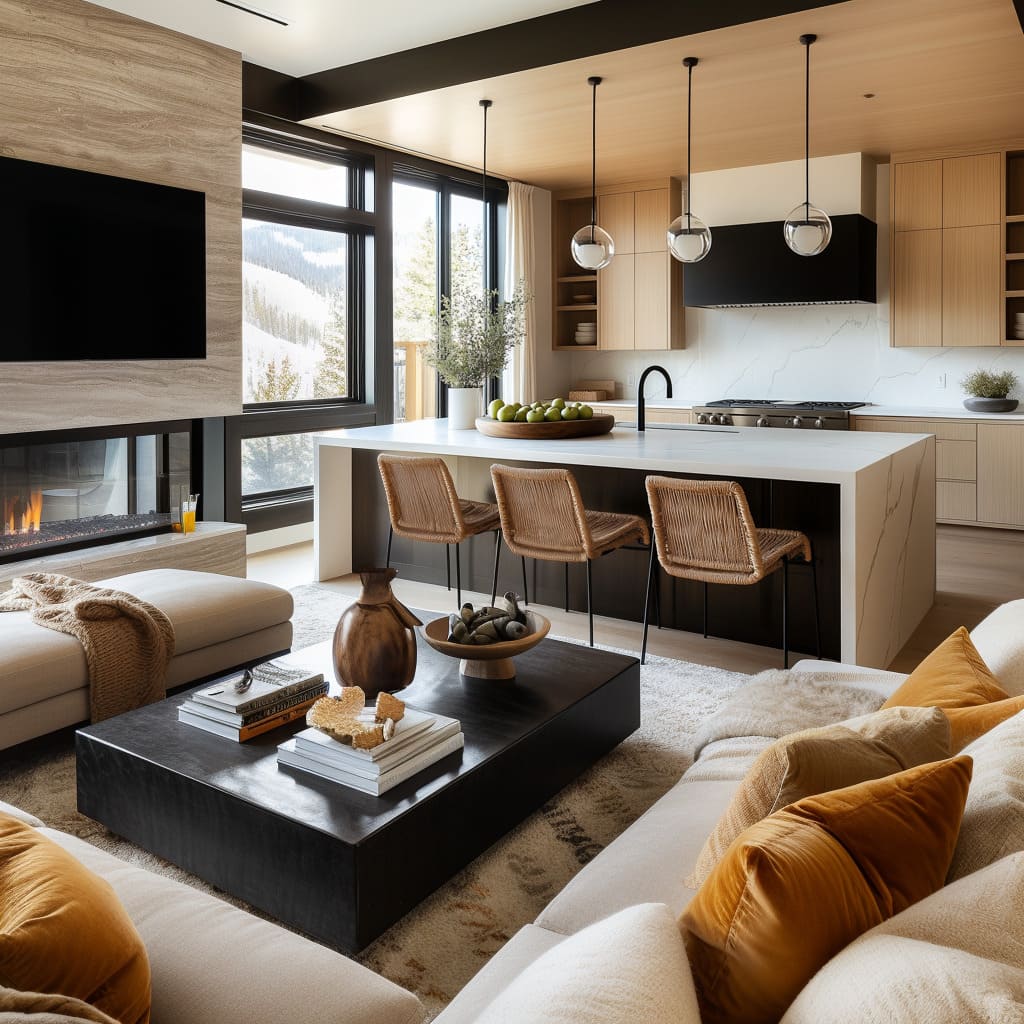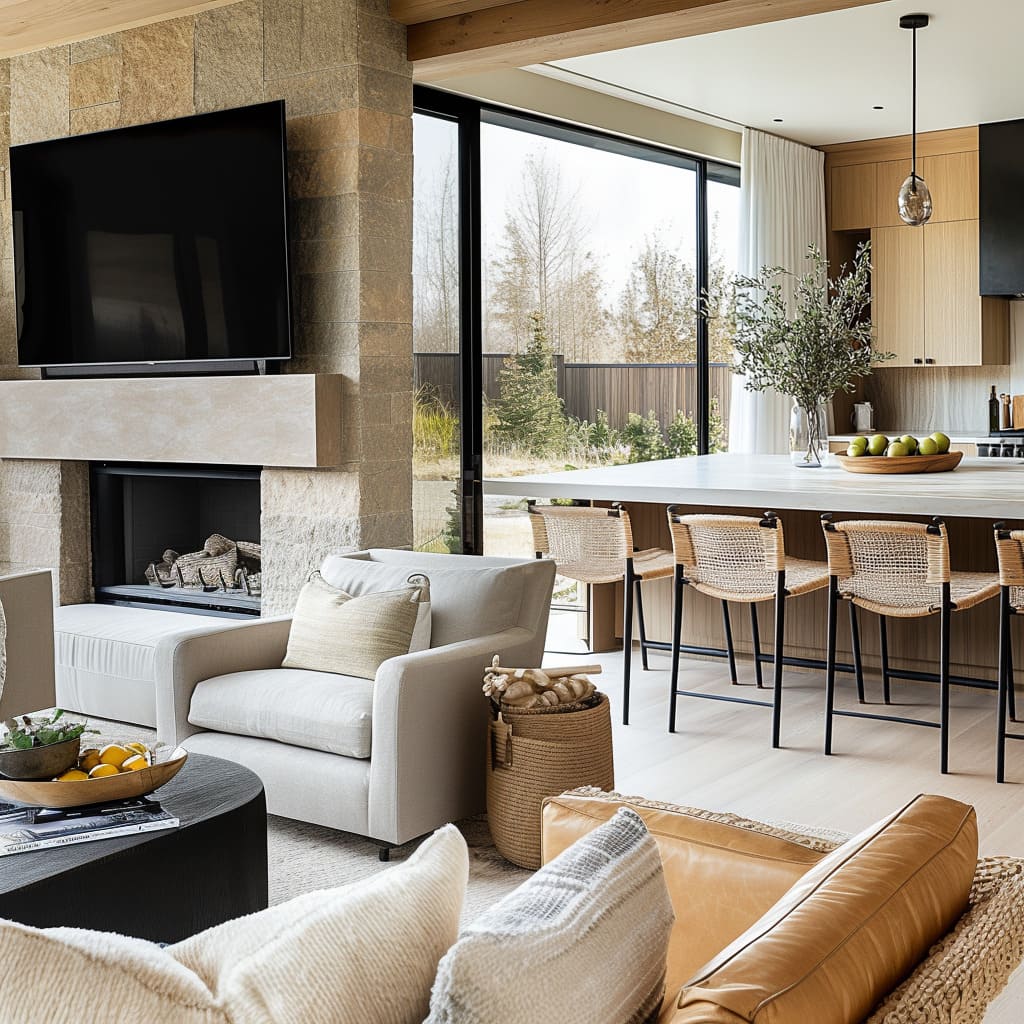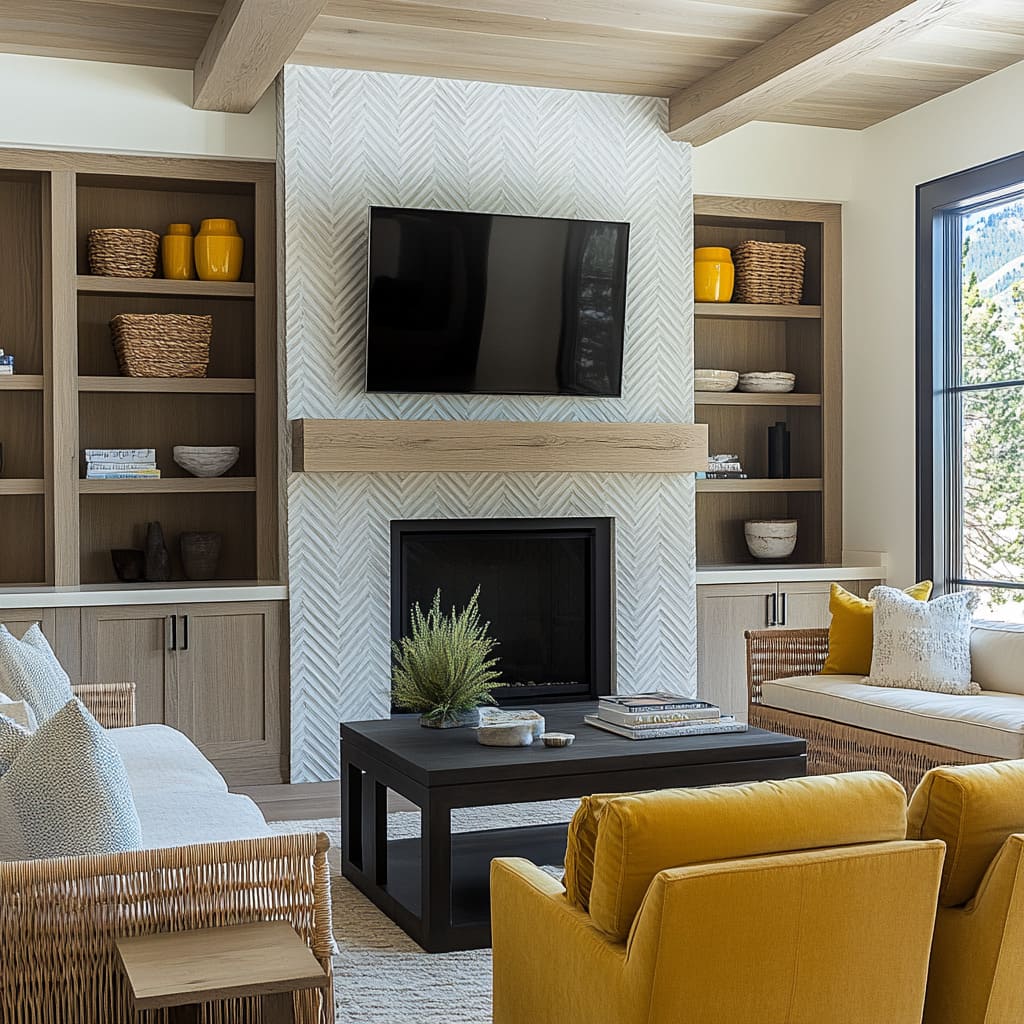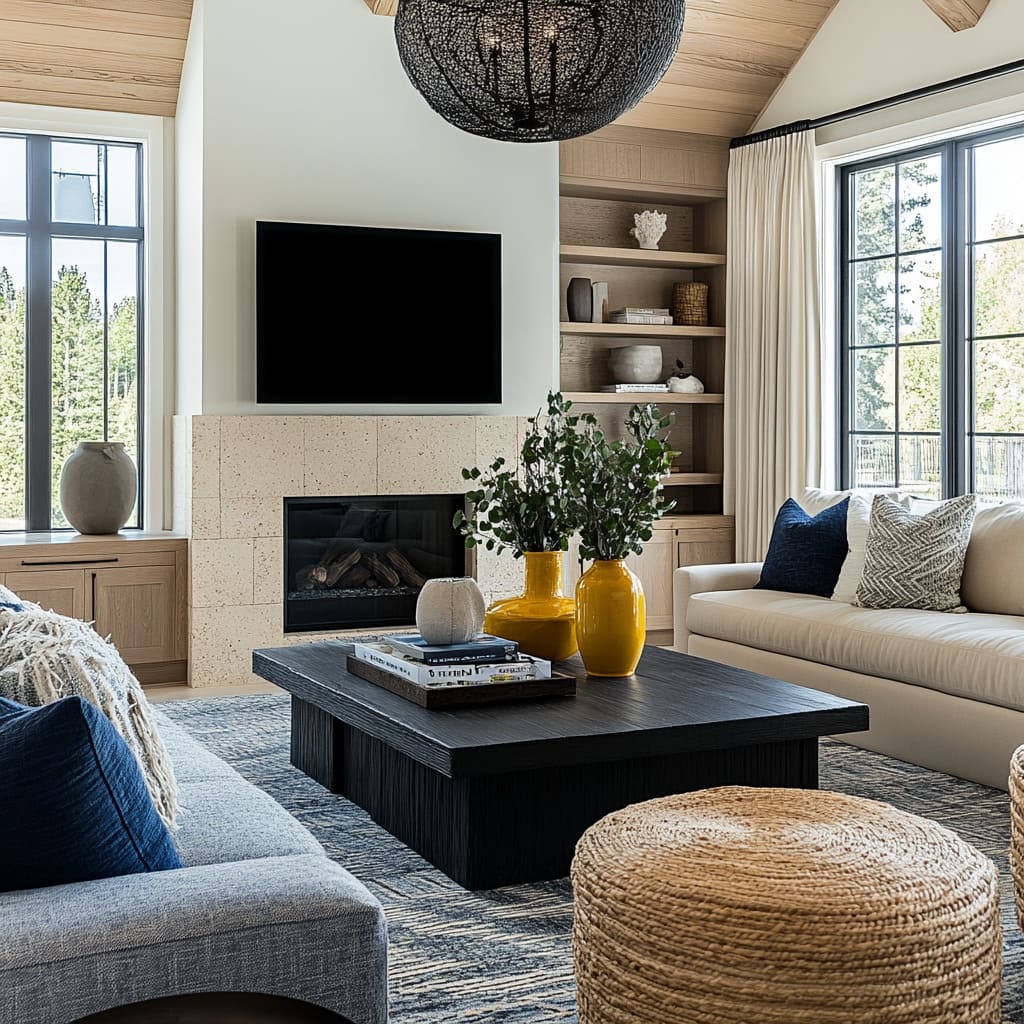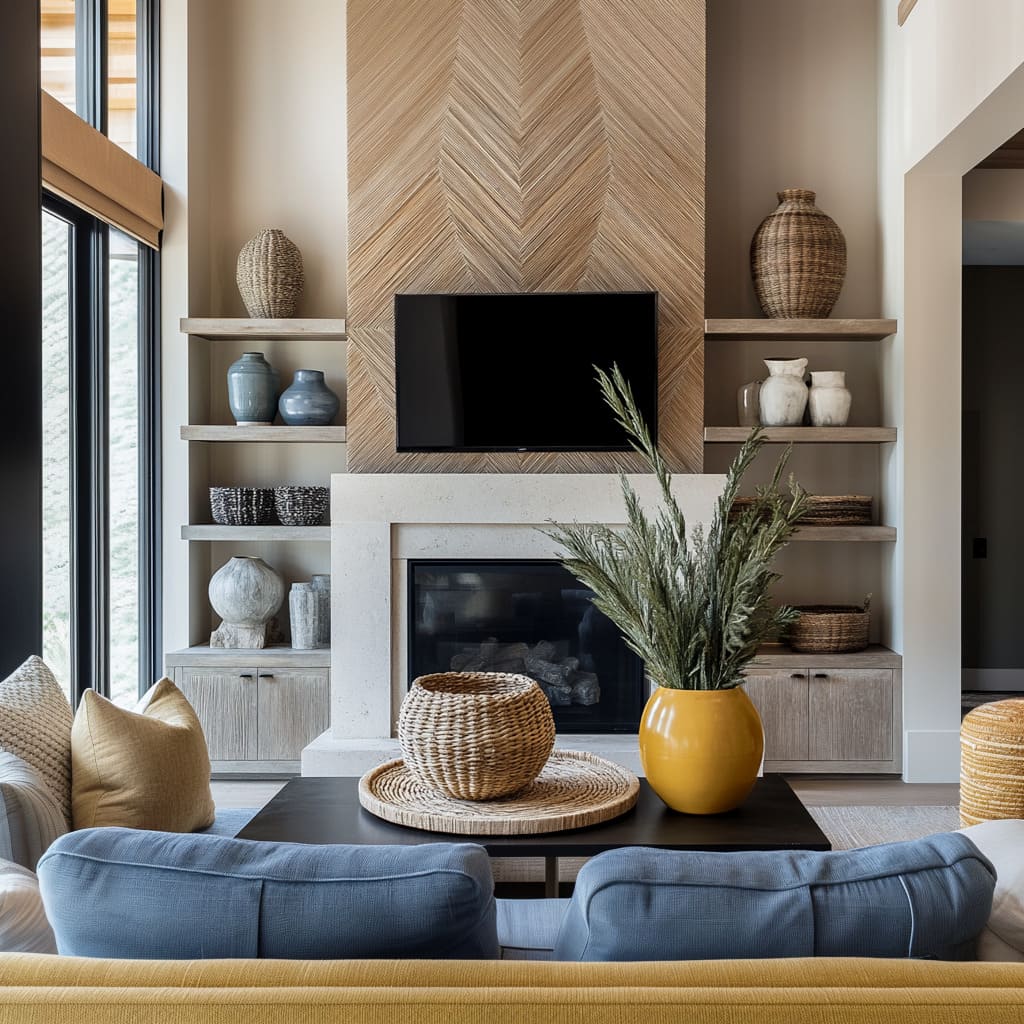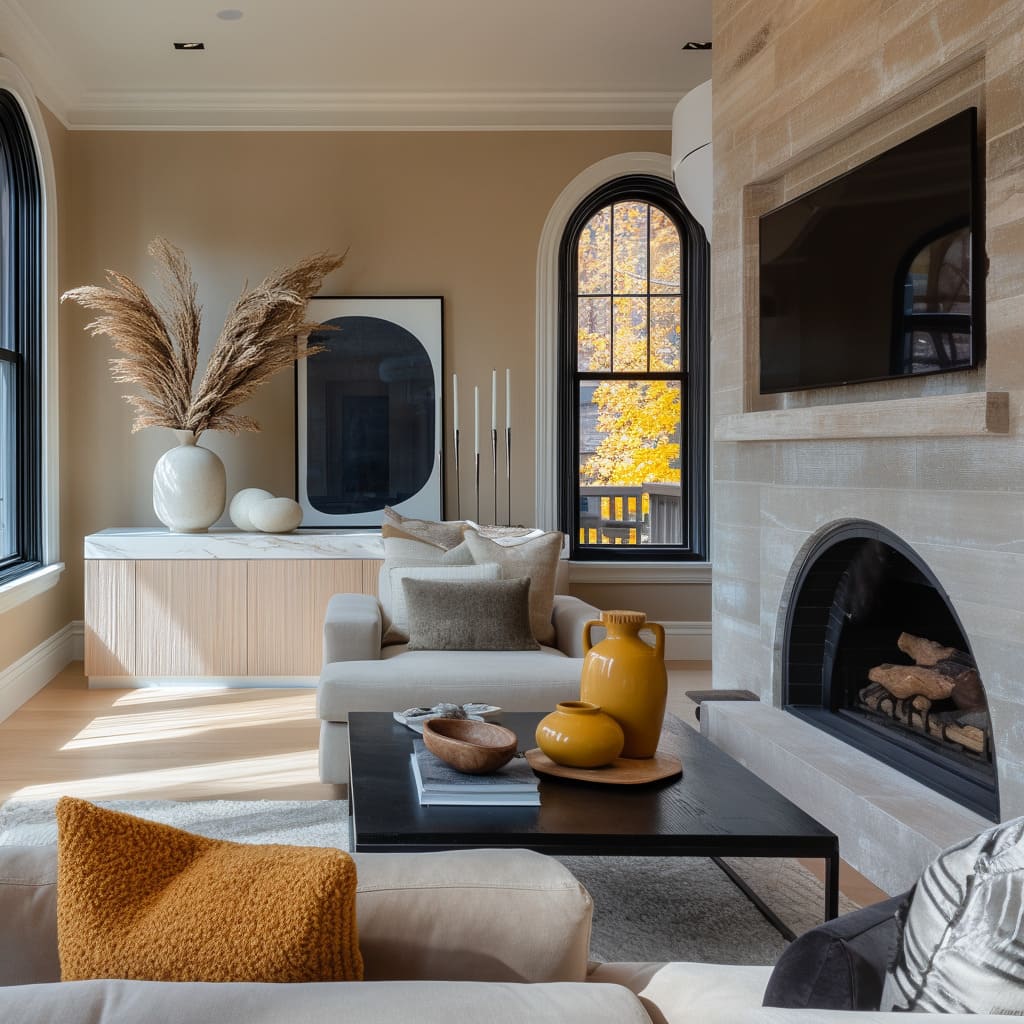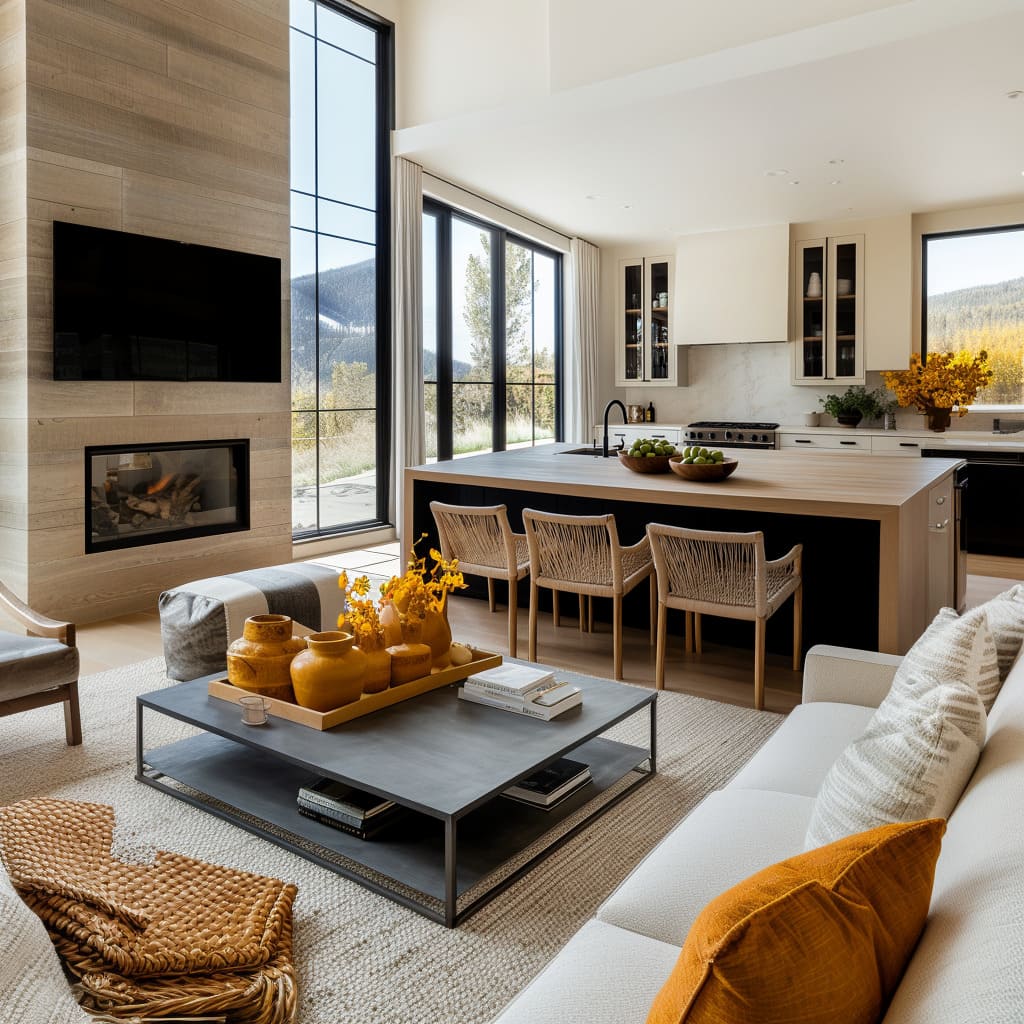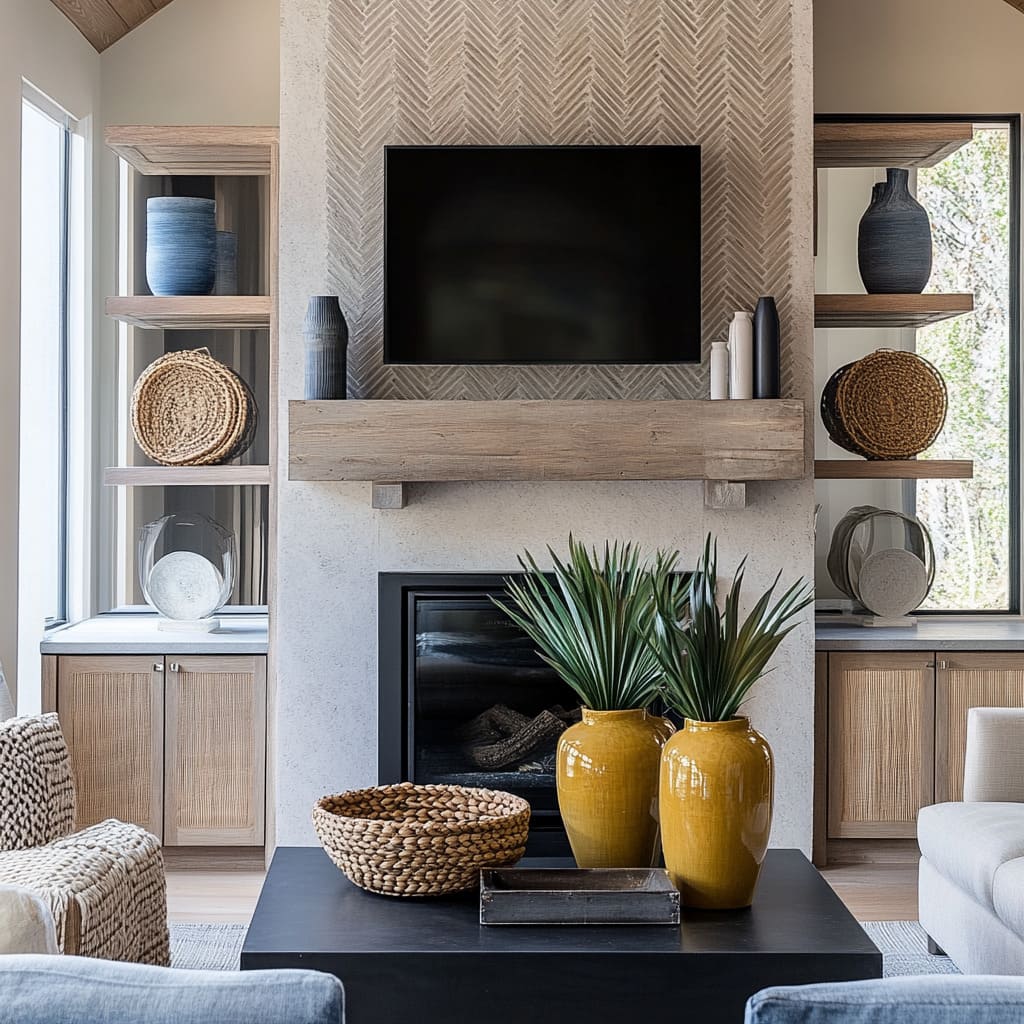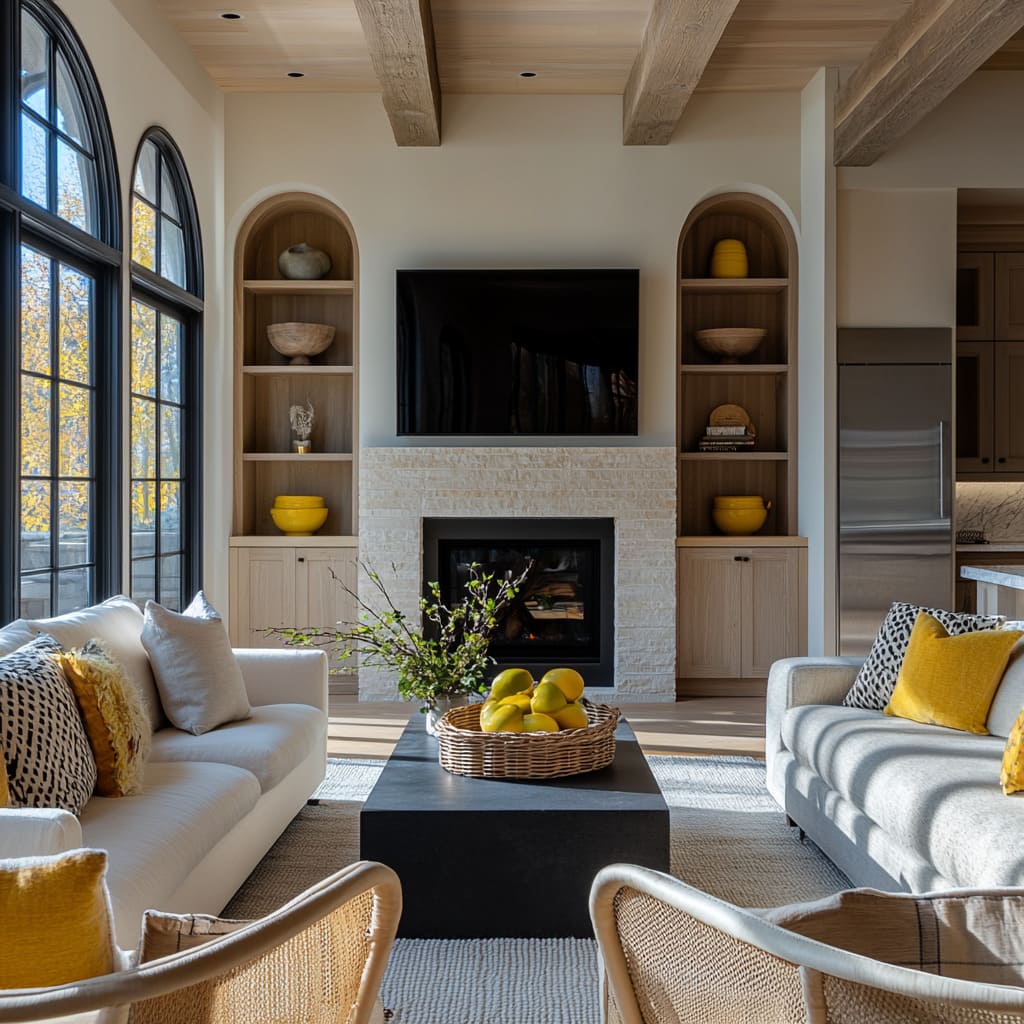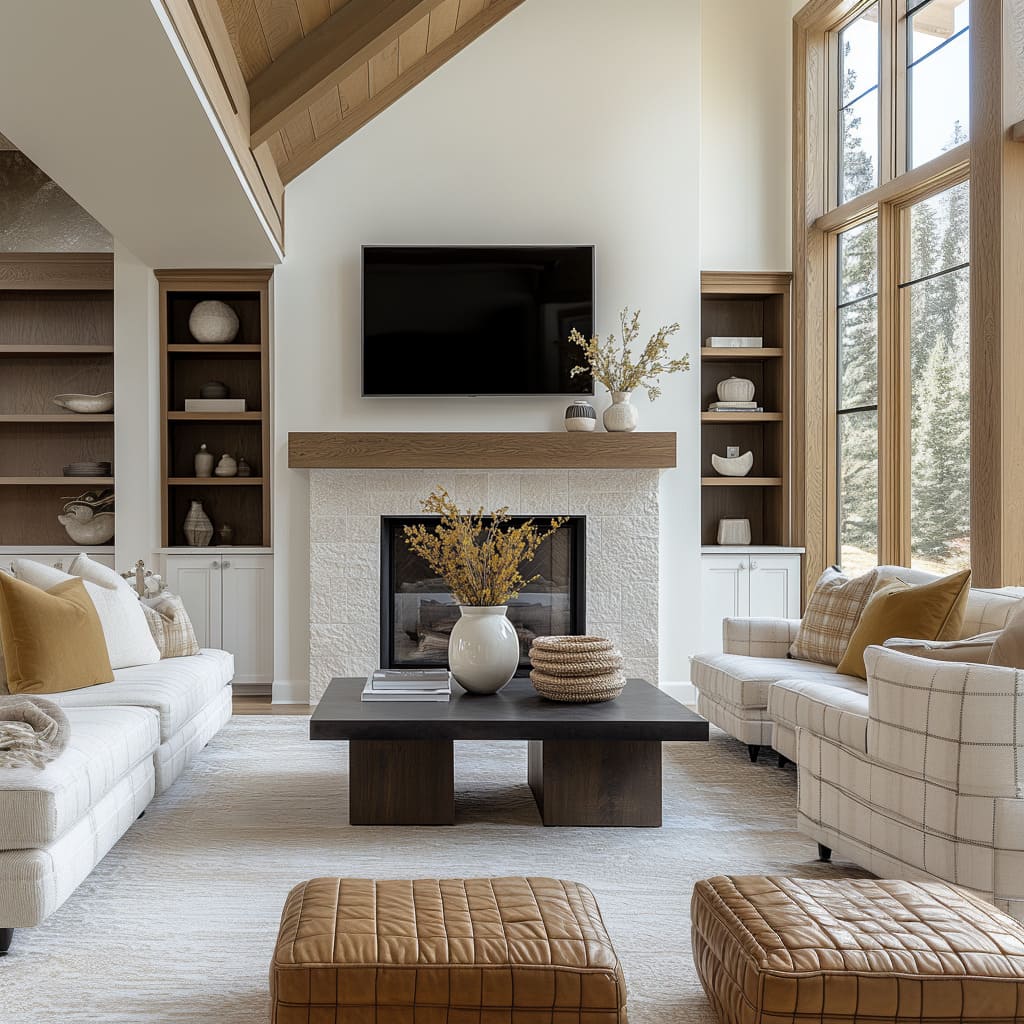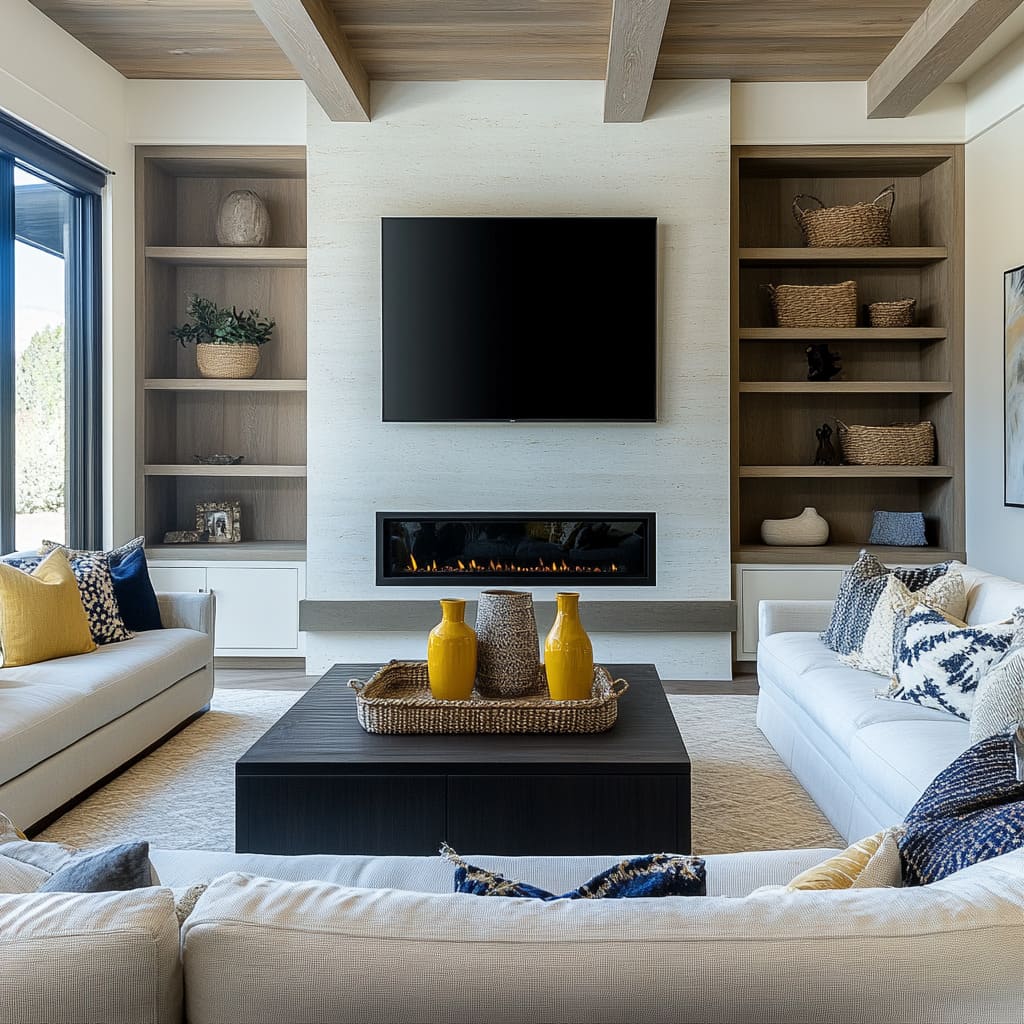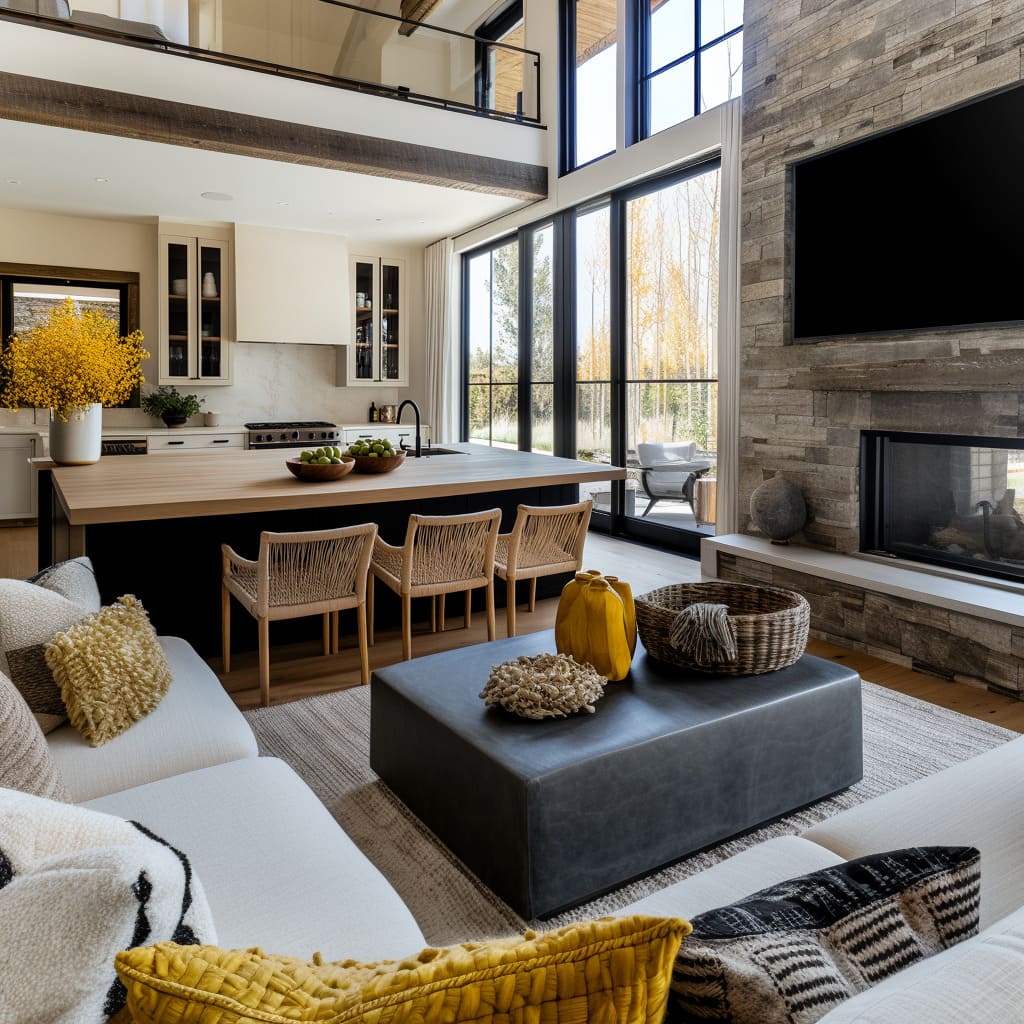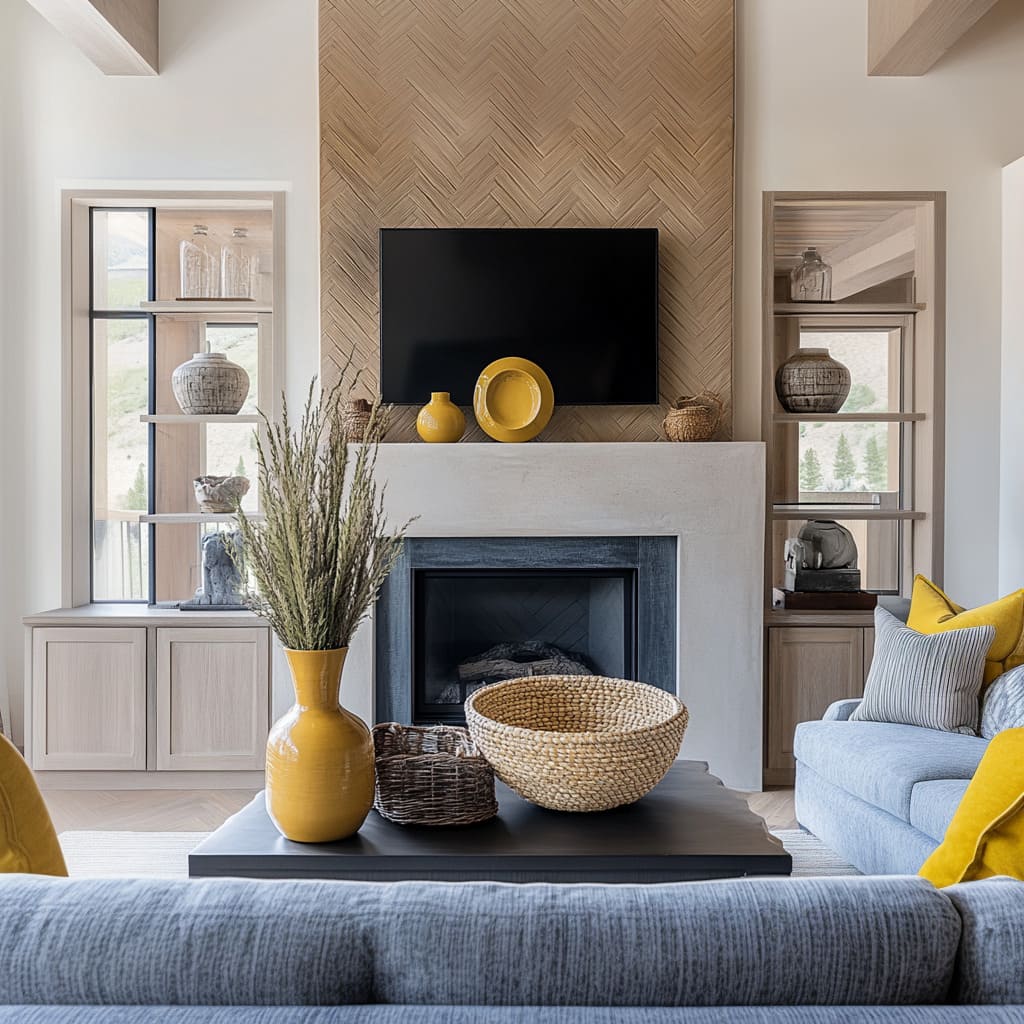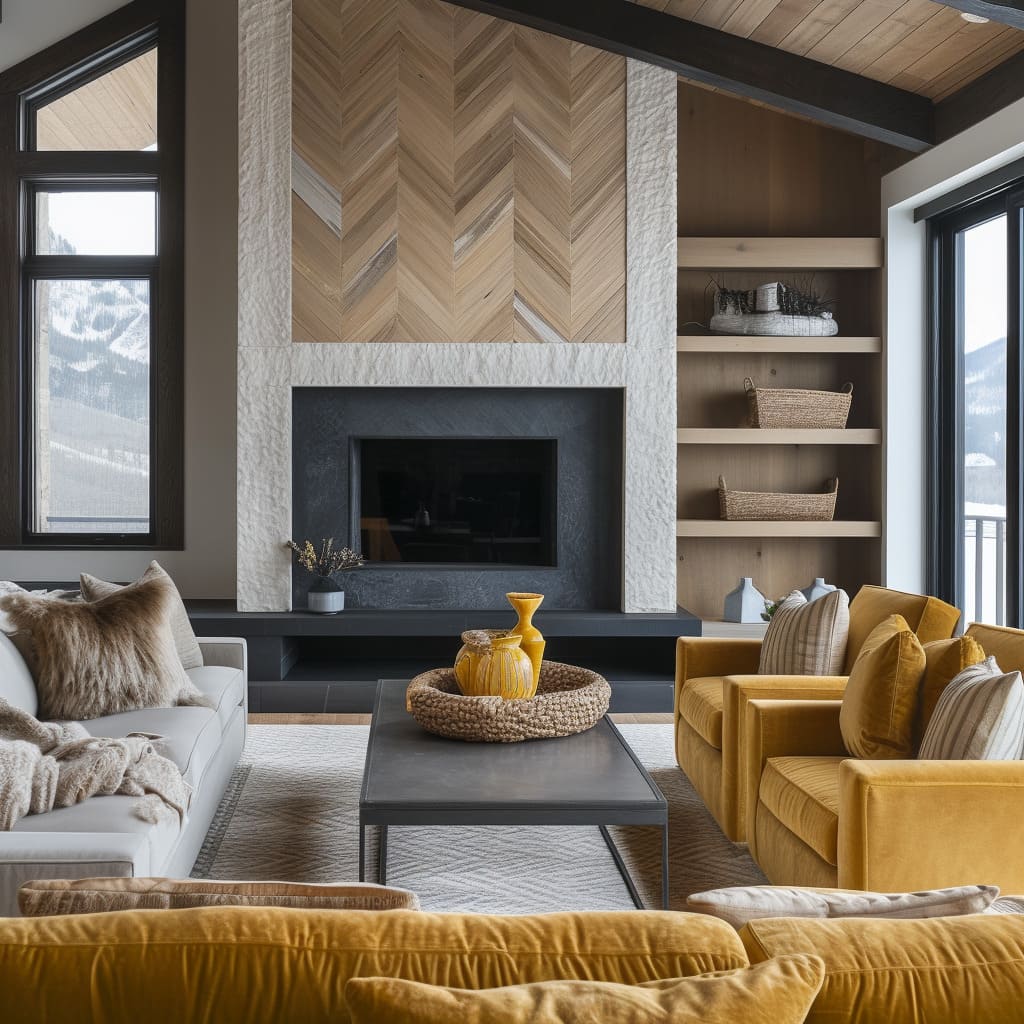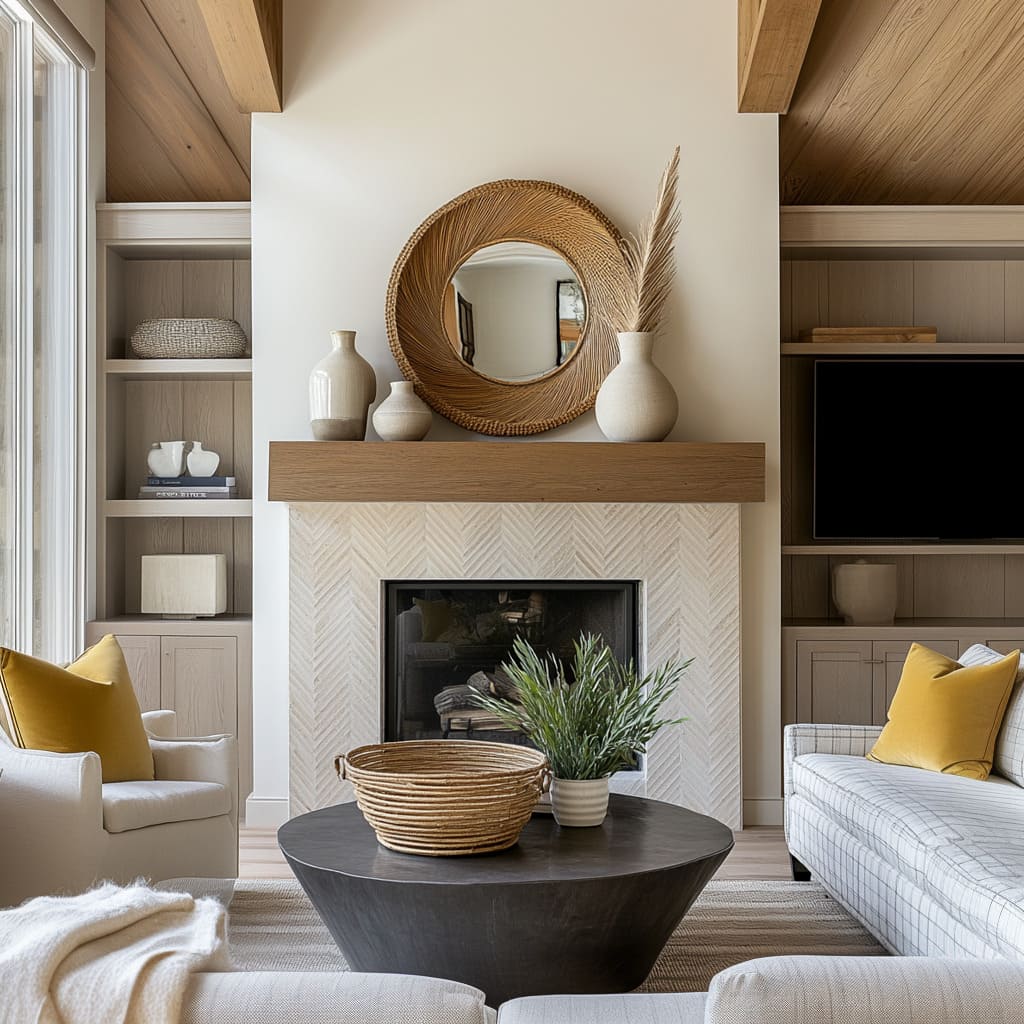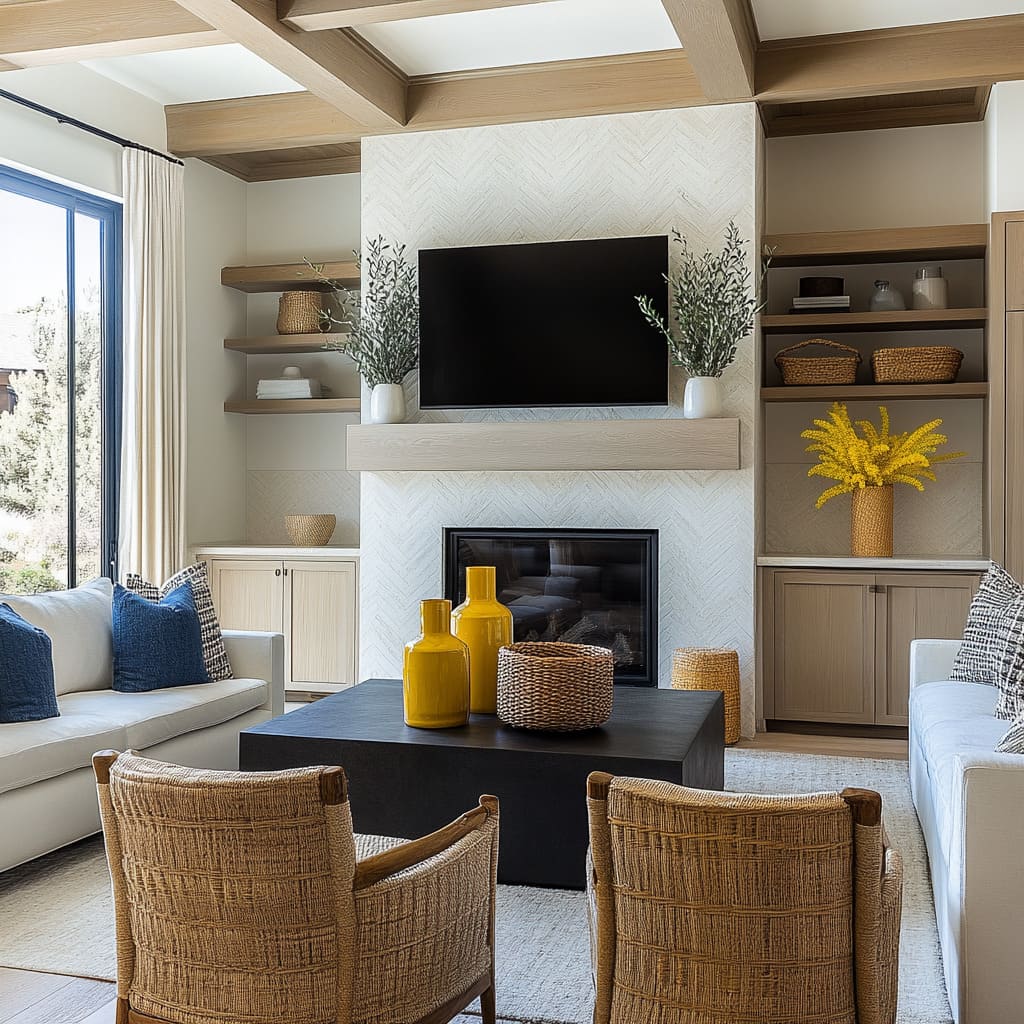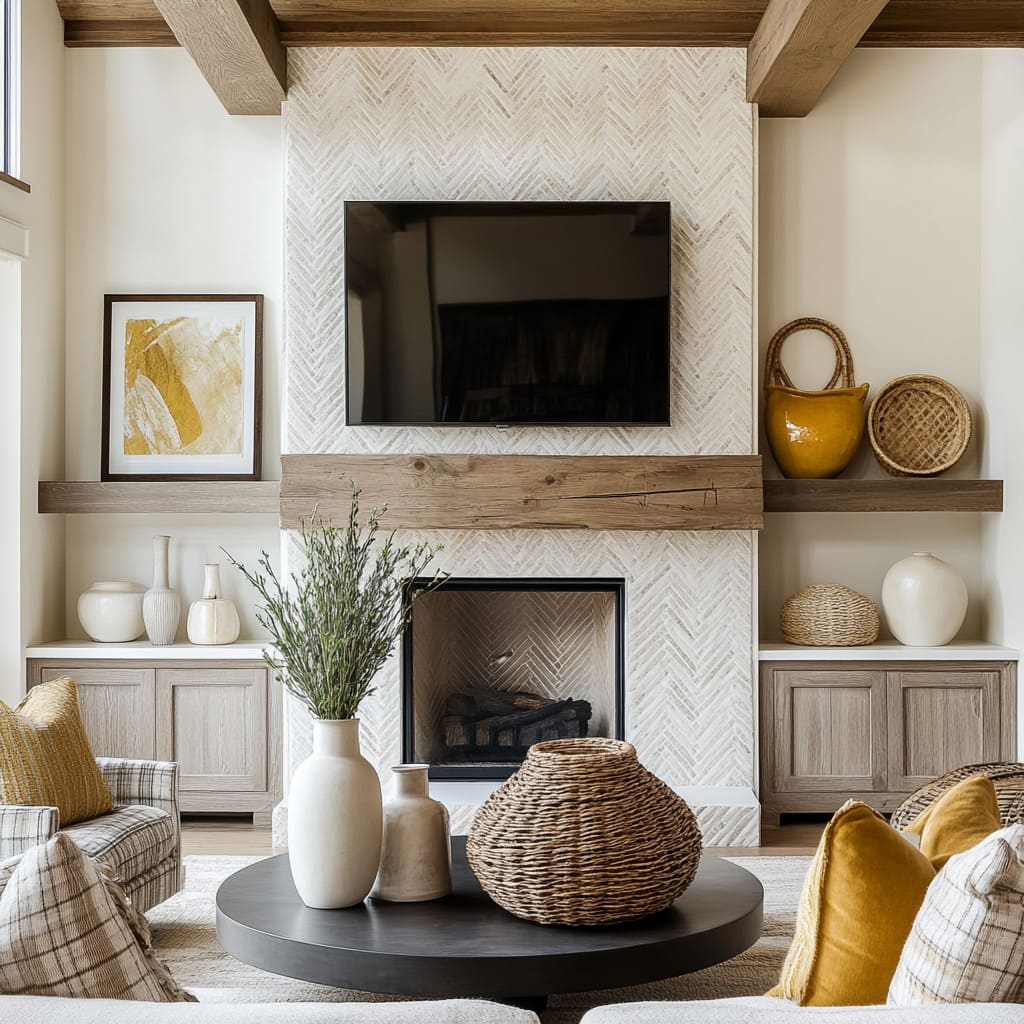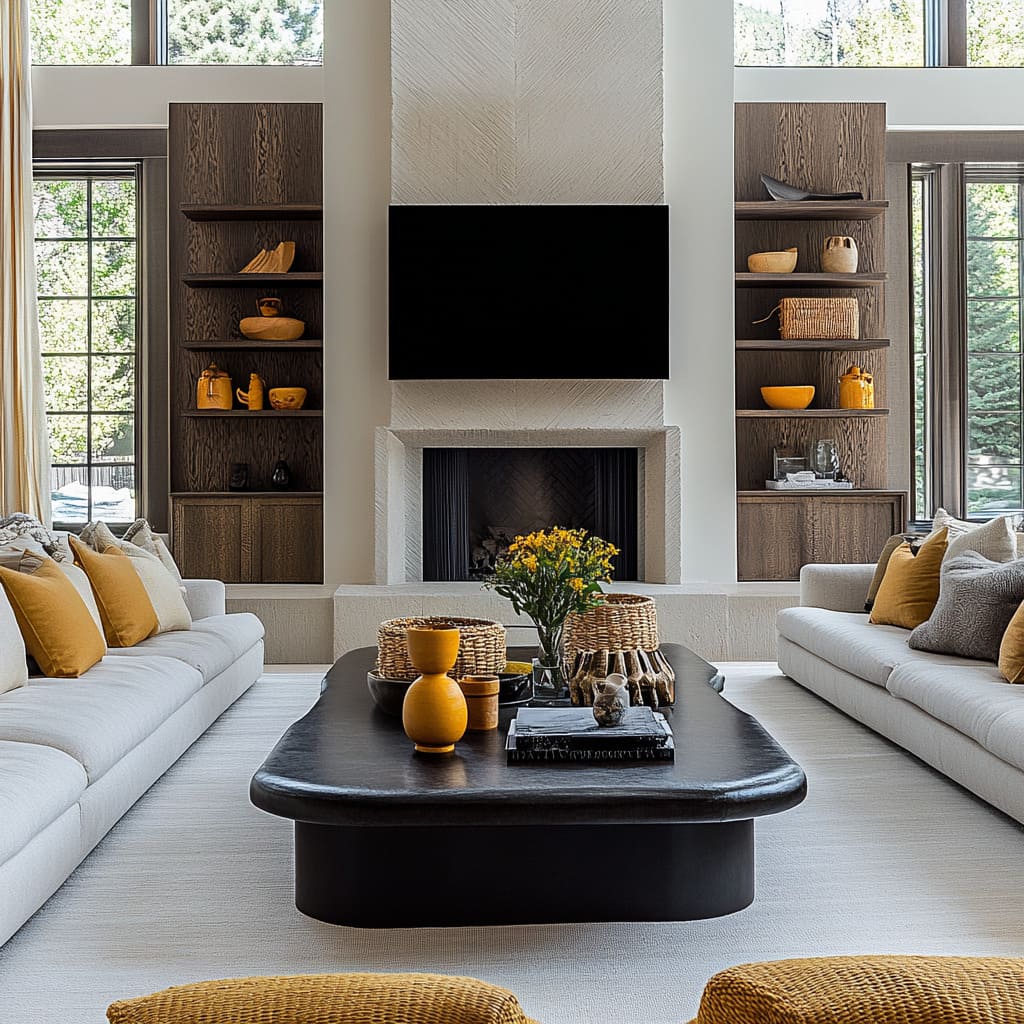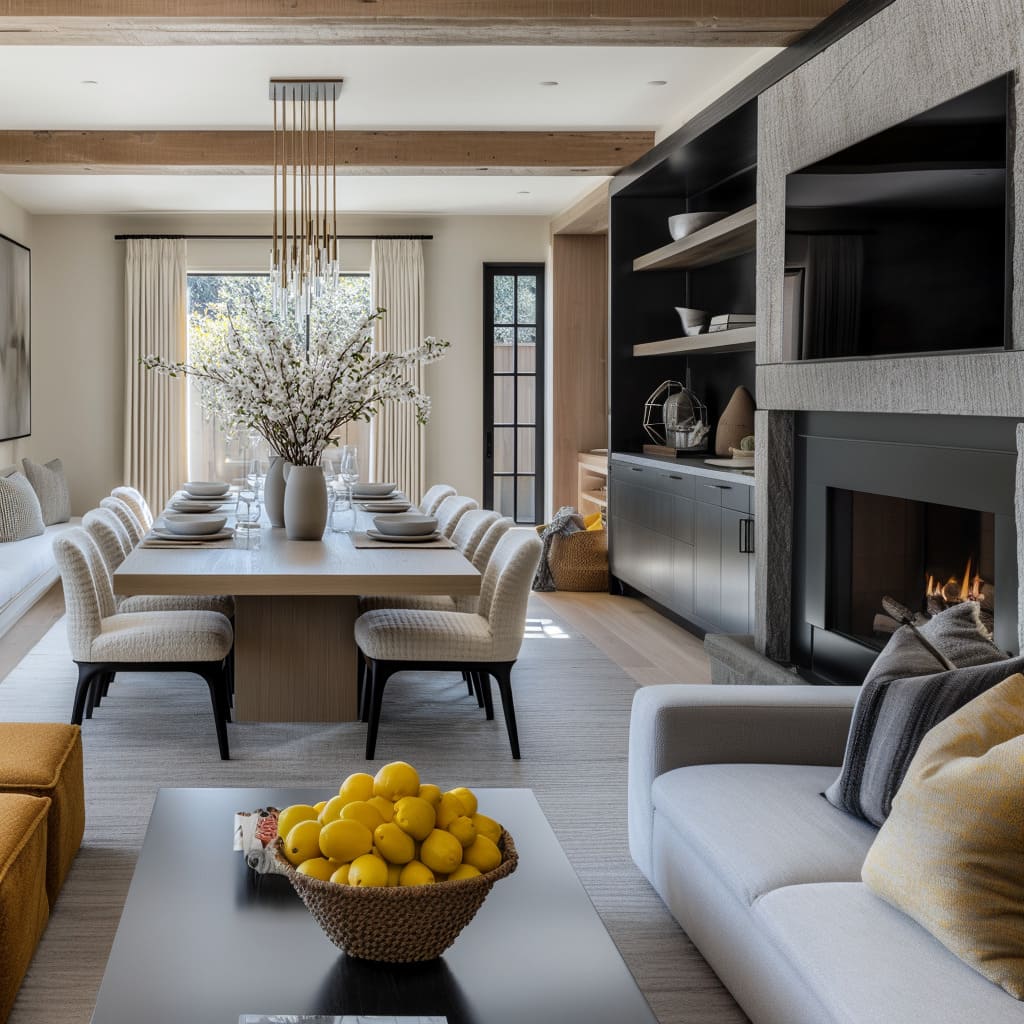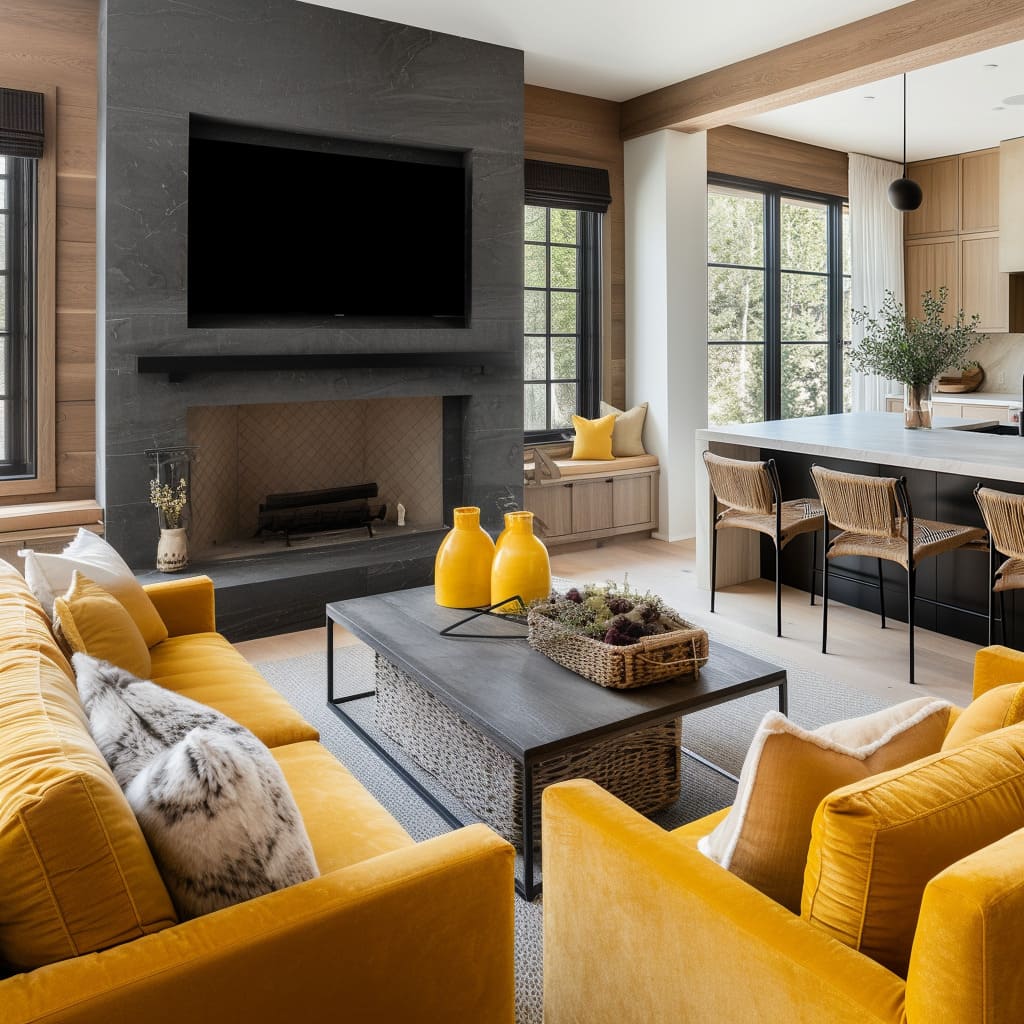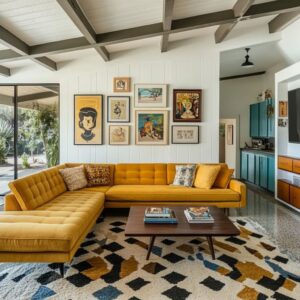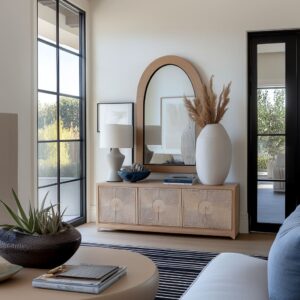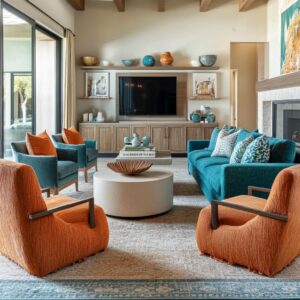Yellow is one of those colors that can completely transform a space when used thoughtfully. In living rooms, it is often a tool for designers to create balance, bring in a sense of warmth, and add layers of personality to an otherwise neutral setting.
The versatility of yellow allows it to work in everything from subtle accents to bold features, making it an ideal choice for modern and transitional interiors. In many designs, yellow is incorporated sparingly yet effectively, allowing its vibrancy to stand out without overwhelming the room.
For instance, in a yellow living room, you might see soft mustard tones in throw pillows or cozy blankets layered on neutral sofas. This deliberate use of yellow as an accent color creates visual interest and draws the eye to key areas of the room, whether it’s a central seating area or a decorative display.
Designers also play with different shades and tones of yellow to suit the specific vibe of the space. Mustard and golden yellows often dominate because they pair seamlessly with warm wood finishes and earthy palettes, common in homes inspired by contemporary and natural aesthetics.
Brighter yellows, meanwhile, are occasionally used to bring in a sunny, cheerful feel, perfect for spaces designed to feel lively and inviting. Another reason yellow works so well in these spaces is its ability to complement other colors while holding its own as a statement hue.
For example, deep blues, soft grays, or creamy whites often serve as the foundation, allowing yellow to become the highlight that ties everything together. This thoughtful color balance ensures the room feels harmonious, even with such a bold accent in the mix.
The choice of textures and finishes in yellow accents also plays a big role in how the color feels in the space. Glossy ceramics add a modern and polished touch, while textured fabrics like knits or woven pieces lend warmth and depth.
This careful layering of textures ensures yellow doesn’t feel out of place but rather becomes an integrated part of the overall design. Ultimately, the way designers use yellow in living rooms highlights its adaptability.
Whether it’s a pop of color in a vase or a more cohesive theme across pillows and art, yellow has the unique ability to inject personality into a space while blending seamlessly with its surroundings. Its cheerful yet grounded qualities make it a go-to color for creating interiors that feel both stylish and welcoming.
Purposeful Use of Yellow to Balance Interiors
Yellow plays a powerful role in creating interiors that feel alive and inviting, without overpowering the space. Designers use this versatile color as an accent to draw attention to specific areas while maintaining a cohesive overall look.
The key lies in its strategic placement and measured use, where yellow punctuates a room’s palette of neutrals, whites, grays, and earthy tones. This thoughtful approach prevents the interiors from feeling flat or overly sterile, introducing just the right amount of warmth and vitality.
In many cases, yellow is incorporated through smaller, moveable elements like pillows, blankets, and vases, which makes it adaptable and versatile. These pieces bring bursts of color while allowing for flexibility in how the design evolves over time.
This method also works beautifully against a backdrop of subdued furnishings and muted walls, ensuring the yellow accents pop without dominating the space. Such yellow decorating ideas are particularly effective in creating a harmonious yet dynamic interior.
Designers also carefully adjust the intensity of yellow based on the ambiance they aim to achieve. In rooms with mostly neutral tones, yellow is used sparingly yet purposefully.
A single ceramic vase, a mustard throw pillow, or even a small framed artwork can provide a spark of energy, making the design feel intentional and polished. This restrained approach keeps the look clean and uncluttered while allowing yellow to serve as a focal point.
In contrast, spaces with deeper contrasts tend to embrace a more layered use of yellow. For example, multiple decor pieces—like cushions, planters, and woven baskets—might feature yellow in various tones.
This creates a rhythm that ties the elements together while maintaining balance. By repeating the color across different textures and forms, designers achieve cohesion without falling into monotony.
The variety of finishes also contributes significantly to the effectiveness of yellow. Glossy ceramics add a modern and reflective quality, while matte and textured fabrics bring depth and a cozy feel.
Soft yellows exude subtlety and blend seamlessly with natural wood tones, while bolder shades bring energy to spaces that need a more vibrant touch. These techniques are a key part of yellow living room ideas that work across a range of design styles, from contemporary to transitional.
The thoughtful use of yellow—whether as a single bold statement or layered with complementary decor—ensures that it remains a harmonious addition, helping interiors feel both balanced and full of life. This approach underscores the power of color to transform spaces while staying grounded in the overall aesthetic vision.
Tones of Yellow and Their Impact
Yellow’s versatility shines through in the variety of tones designers incorporate into interiors. Each shade is carefully chosen to complement the room’s overall mood, color palette, and purpose.
Whether it’s a deep mustard or a fresh lemon tone, every choice is intentional, enhancing the space without overwhelming it. These tones add character and warmth, helping interiors feel cohesive and thoughtfully curated.
Mustard Yellow: This rich, muted tone dominates in many designs, thanks to its ability to pair seamlessly with natural wood finishes, warm neutrals, and even darker accents like black. Mustard’s subtle depth makes it suitable for larger accents, such as upholstered armchairs or cozy throws.
Its muted nature ensures it doesn’t compete with other elements, instead bringing a grounded, sophisticated warmth to the space. This shade often works beautifully in rooms aiming for a cozy, layered aesthetic, balancing the vibrancy of yellow with a more subdued feel.
It’s a prime example of how a warm yellow living room can exude both comfort and style.
Golden Yellow: A brighter, more vibrant tone, golden yellow is used sparingly but strategically to draw the eye to focal points. Its sunny quality makes it ideal for statement pieces like vases, bold pillows, or accent trays.
The vibrancy of golden yellow works best when contrasted against softer neutrals or darker tones, ensuring it acts as a spotlight rather than overwhelming the space. In many designs, this shade helps elevate the energy of the room, adding a cheerful yet refined brightness.
Lemon Yellow: Light and airy, lemon yellow is frequently employed in spaces designed to feel fresh and cheerful. This softer shade is often seen in smaller decor items, like bowls, floral arrangements, or even patterned cushions.
Its delicate tone blends effortlessly with lighter interiors, maintaining a bright, uplifting atmosphere. Lemon yellow’s subtle presence adds just enough personality without interrupting the overall serenity of the space.
What makes yellow so effective is its adaptability to the room’s specific needs. It can be bold and commanding or gentle and understated, depending on the chosen shade and the elements it’s paired with.
When used as part of yellow decorating ideas for living rooms, these tones work in harmony with the room’s textures and finishes. The finishes themselves—whether glossy, matte, or textured—play a vital role in how these tones are perceived.
Glossy finishes, often found in vases or ceramics, add a modern touch and reflect light, enhancing the color’s brightness. Matte finishes, seen in fabrics like throws and cushions, soften the overall effect, adding depth and coziness.
Meanwhile, textured finishes, such as woven baskets or patterned rugs, lend an organic feel, grounding the yellow accents in natural elements. By carefully balancing these tones and finishes, designers ensure that yellow serves as a dynamic part of the design without overpowering it.
The interplay of mustard, golden, and lemon tones, paired with thoughtful placement, creates interiors that feel warm, inviting, and visually interesting. This nuanced approach demonstrates the limitless possibilities yellow offers in interior design, from subtle highlights to bold statements.
Finishes of Yellow and Their Effects
The texture and finish of yellow accents significantly influence their impact on a room’s overall aesthetic. Designers take a thoughtful approach to choosing finishes, ensuring that they harmonize with other materials and add layers of interest to the interior.
These finishes allow yellow accents to serve as focal points or subtle enhancers, depending on the design’s goals. Glossy Finishes: Glossy ceramic vases, bowls, and other decorative objects in shades like mustard or golden yellow bring a reflective quality to living spaces.
These accents catch and reflect light, making them ideal for introducing a polished, modern look. For example, a glossy yellow bowl placed on a dark coffee table creates a striking contrast, enhancing both the object and its surroundings.
When incorporated into spaces with a yellow sofa living room, glossy finishes add a touch of sophistication while maintaining cohesion with the softer finishes often found in upholstered furniture.
Matte and Textured Finishes: Yellow accents with matte finishes, such as throw pillows or blankets, offer a grounded and calming effect. Unlike glossy surfaces, matte textures diffuse light, making them feel softer and more approachable.
When these accents are combined with textured fabrics, like knits or weaves, they add both visual and tactile appeal. These choices are particularly effective in rooms where comfort and coziness are prioritized, such as those featuring plush sofas or inviting seating areas.
The balance between smooth and textured elements ensures a dynamic yet harmonious design.
Soft Finishes: Fabric-based yellow accents, including cushions and throws, add an inviting warmth to any space. These soft finishes temper the vibrancy of yellow, making it feel less bold and more integrated with the room’s overall palette.
For example, a mustard yellow throw draped over a neutral-colored sofa creates a welcoming focal point without feeling overpowering. In open-concept designs, these soft elements subtly bridge the gap between different zones, ensuring a cohesive look.
Natural Textures: Designers often incorporate yellow accents with natural textures, such as woven baskets or dried floral arrangements, to bring an organic feel to the space. These elements pair seamlessly with wood finishes and other earthy tones, enhancing the natural warmth of the room.
In living rooms with rustic or modern farmhouse aesthetics, these organic yellow accents blend functionality with style, contributing to a relaxed yet refined ambiance.
The intentional contrast between finishes—glossy with matte, textured with smooth—creates a layered effect that draws the eye and keeps the design balanced. Glossy finishes provide brightness and a sense of luxury, while matte and textured pieces add warmth and depth.
Soft finishes ensure the design remains comfortable and inviting, while natural textures ground the yellow elements in a more understated way. By carefully mixing and matching these finishes, designers achieve an equilibrium that allows yellow to shine without dominating the space.
Whether it’s a vase, a pillow, or a yellow sofa living room, these thoughtful choices ensure that each accent serves its purpose within the broader design narrative, creating interiors that feel intentional, cohesive, and beautifully balanced.
Balancing More or Less Yellow
Designers exhibit remarkable skill in adjusting the intensity and volume of yellow within interiors, carefully adapting its use to enhance the room’s overall aesthetic. The decision to incorporate either a minimal or generous amount of yellow is always dictated by the unique characteristics of the space, such as size, natural light, and the surrounding palette.
Minimal Use of Yellow: In rooms where wood tones and neutral shades dominate, yellow is introduced in small but meaningful amounts to maintain a calm and understated look. For example, a single yellow vase placed on a coffee table or a neatly arranged pillow on the sofa draws attention without disrupting the balance of the design.
This restrained approach proves that less can indeed be more, as the limited use of yellow creates a deliberate focal point. Such minimalist touches are especially effective in spaces where subtlety and elegance are desired.
A yellow sitting room with predominantly soft wood tones or light gray walls demonstrates how even a single yellow accent can energize the space without overpowering it.
Generous Use of Yellow: In more daring designs, yellow takes center stage through layered accents spread across the room. Pillows, throws, vases, bowls, and even floral arrangements combine to ensure a cohesive and dynamic look.
By using these elements repeatedly, designers prevent the yellow from feeling isolated, instead creating a rhythmic flow throughout the interior. Muted shades, like mustard, are commonly chosen for this purpose, as their subdued nature adds warmth and character without overwhelming the senses.
This approach works particularly well in rooms with strong contrasts, where the repetition of yellow accents ties the overall design together.
Achieving Balance Through Calibration: The amount of yellow is always fine-tuned based on the room’s size, lighting, and existing base colors. In larger rooms with ample natural light, more yellow can be used effectively without making the space feel over-saturated.
Conversely, smaller rooms or those with limited natural light benefit from sparing use, ensuring that yellow serves as a highlight rather than a dominating force. Adapting Yellow to Base Palettes: Designers consider the base palette when deciding the degree of yellow to incorporate.
Neutral backdrops like gray, beige, and white allow yellow accents to pop, while earthy tones create a harmonious connection with the vibrant color. For example, a yellow throw blanket draped over a beige sofa strikes a perfect balance between contrast and cohesion.
In rooms with darker elements like black or deep brown, yellow provides a lively counterpoint, brightening the overall atmosphere.
Texture and Proportion: The effectiveness of yellow is also tied to the textures and proportions of the items used. A textured yellow pillow adds depth and softness to a room with sleek furniture, while a glossy yellow vase on a matte-finished table creates visual contrast.
Designers often ensure that larger yellow items, like blankets or multiple pillows, are balanced by smaller decor pieces in neutral shades to avoid overwhelming the space. Why It Works: Whether applied minimally or generously, yellow’s ability to inject energy, warmth, and focus into a room makes it an invaluable design tool.
Its adaptability to different styles and its capacity to complement a wide range of palettes ensure it remains versatile and timeless. Thoughtful placement and an understanding of proportion allow yellow to shine without taking over, making it a key player in creating interiors that feel both lively and balanced.
Why Yellow Works So Well
Yellow holds a unique ability to energize and uplift interior spaces while seamlessly blending with modern design elements. Its warm and cheerful nature allows it to stand out as a focal point while complementing the neutral tones and organic materials that are often the backbone of contemporary living room designs.
This balance of vibrancy and harmony is one of the reasons yellow has become a staple for adding personality to interiors. Yellow works wonders in brightening darker spaces, particularly those with stone-clad walls or muted color palettes.
Its energy acts as a counterbalance, preventing the room from feeling overly heavy or somber. For instance, a well-placed yellow vase on a textured stone coffee table immediately draws the eye and lifts the ambiance, showcasing how even a small accent can make a significant impact.
Another strength of yellow lies in its ability to enhance warmth in interiors dominated by natural wood tones and organic finishes. The golden undertones of mustard or ochre yellow, for example, complement the grainy textures of wood furniture and beams, adding depth and a cohesive sense of comfort.
This combination is particularly effective in cozy living rooms with a rustic edge, where the interplay of warmth and texture creates a welcoming atmosphere. Yellow also excels at introducing visual interest to rooms with monochromatic or understated palettes.
In a blue and yellow living room, for example, the contrast between navy and golden yellow creates a dynamic pairing that feels both bold and balanced. The richness of blue tempers yellow’s brightness, while yellow, in turn, adds vibrancy to the moody undertones of blue.
This complementary relationship amplifies the impact of both colors, making the design feel intentional and layered.
The versatility of yellow also allows it to pair effortlessly with softer shades like beige, light gray, and charcoal. These subdued tones act as grounding elements, tempering yellow’s inherent brightness without diminishing its lively appeal.
Designers often use this interplay to craft a harmonious balance, as seen in rooms where muted yellow cushions rest against beige sofas, or where charcoal vases anchor golden accents. What truly sets yellow apart is its adaptability across a wide range of design styles and moods.
It can feel playful and fresh in light, airy spaces, or rich and sophisticated in darker, more dramatic rooms. This flexibility ensures that yellow remains a timeless choice for designers seeking to infuse interiors with character, warmth, and an undeniable sense of joy.
Insights and Nuances for a Stunning Look
A closer look at these yellow-infused designs reveals several nuanced strategies that designers use to achieve their stunning results:
Distributed Focus
Designers skillfully distribute yellow across multiple areas of a room instead of confining it to a single focal point. This approach ensures that the eye is drawn naturally through the space, creating a sense of balance and flow.
For example, a yellow throw on a sofa might be echoed by a vase on a shelf or a cushion on a nearby armchair. This technique avoids overwhelming the space while ensuring the color feels intentional and cohesive, making it an effective strategy for achieving seamless yellow living room decor ideas.
Material Harmony
The use of yellow is frequently paired with natural materials like wood, stone, and woven accents, adding to the organic feel of the designs. These materials soften yellow’s vibrancy, allowing it to feel grounded and well-integrated.
A bright yellow bowl, for instance, placed on a wooden coffee table or next to woven baskets, blends effortlessly into the room’s aesthetic. This pairing ensures that even bold shades of yellow complement rather than compete with the surrounding elements.
Dynamic Layering
Textural contrast plays a crucial role in elevating these designs. Designers often juxtapose glossy finishes with matte or textured ones to create visual depth.
A shiny yellow vase might be strategically placed on a matte black table, while a plush mustard-yellow pillow is paired with a natural linen sofa. These contrasts not only add layers of interest but also ensure that the yellow accents are dynamic and multidimensional, enhancing the sophistication of the space.
Yellow as Seasonal Flexibility
One of the most insightful observations is how yellow is used in easily replaceable decor items. From cushions and throws to vases and bowls, these accents can be swapped out effortlessly to match changing seasons or trends.
This flexibility ensures the longevity of the design, allowing homeowners to adapt their interiors without needing significant updates. For instance, a summery yellow can be replaced with muted tones in colder months, maintaining the room’s freshness year-round.
Emotional Warmth and Visual Impact
Yellow’s warmth creates an inviting atmosphere, particularly in spaces that might otherwise feel too cold or formal. Designers leverage this by incorporating the color in areas that benefit from added comfort, such as seating zones or display shelves.
Even when paired with contrasting tones like black or charcoal, yellow retains its optimistic and cheerful qualities, ensuring the room feels lively yet balanced.
The Power of Moderation
Finally, the use of yellow highlights the importance of moderation. Even in rooms with more generous yellow accents, the color is layered thoughtfully, ensuring it never dominates the design.
This balance is achieved by pairing yellow with neutral bases, like beige or gray, and tempering its brightness with deeper or earthier tones. The result is a room that feels harmonious and vibrant without crossing into excess.
By incorporating these strategies, designers transform yellow from a potentially overwhelming hue into a versatile and timeless design tool, demonstrating its power to elevate interiors with style and grace.
Conclusion
Through intentional and thoughtful design, yellow is skillfully incorporated into living room interiors to bring warmth, vibrancy, and depth. By carefully balancing tones, textures, and placements, designers achieve harmony between yellow accents and the broader palette of each space.
Whether it’s a soft mustard pillow, a glossy vase in golden yellow, or a lemon-hued floral arrangement, each element is curated to enhance the aesthetic while complementing natural materials like wood and stone.
Yellow’s versatility is showcased in its ability to adapt to different styles, moods, and spaces. In minimal spaces, yellow serves as a subtle punctuation mark, while in more dynamic interiors, it takes a central role without overwhelming the design.
The strategic use of finishes—matte, glossy, and textured—further amplifies its visual appeal, creating layers of interest that feel both deliberate and cohesive.
This analysis highlights how yellow transforms spaces into uplifting yet balanced environments, making it an enduring favorite for modern interiors. From small accents to bold statements, the designs emphasize the flexibility of yellow, offering endless possibilities for creating inviting, stylish rooms.
For anyone seeking inspiration, these yellow room ideas illustrate the perfect blend of creativity and function, proving that this cheerful hue has a well-deserved place in contemporary living room aesthetics.
